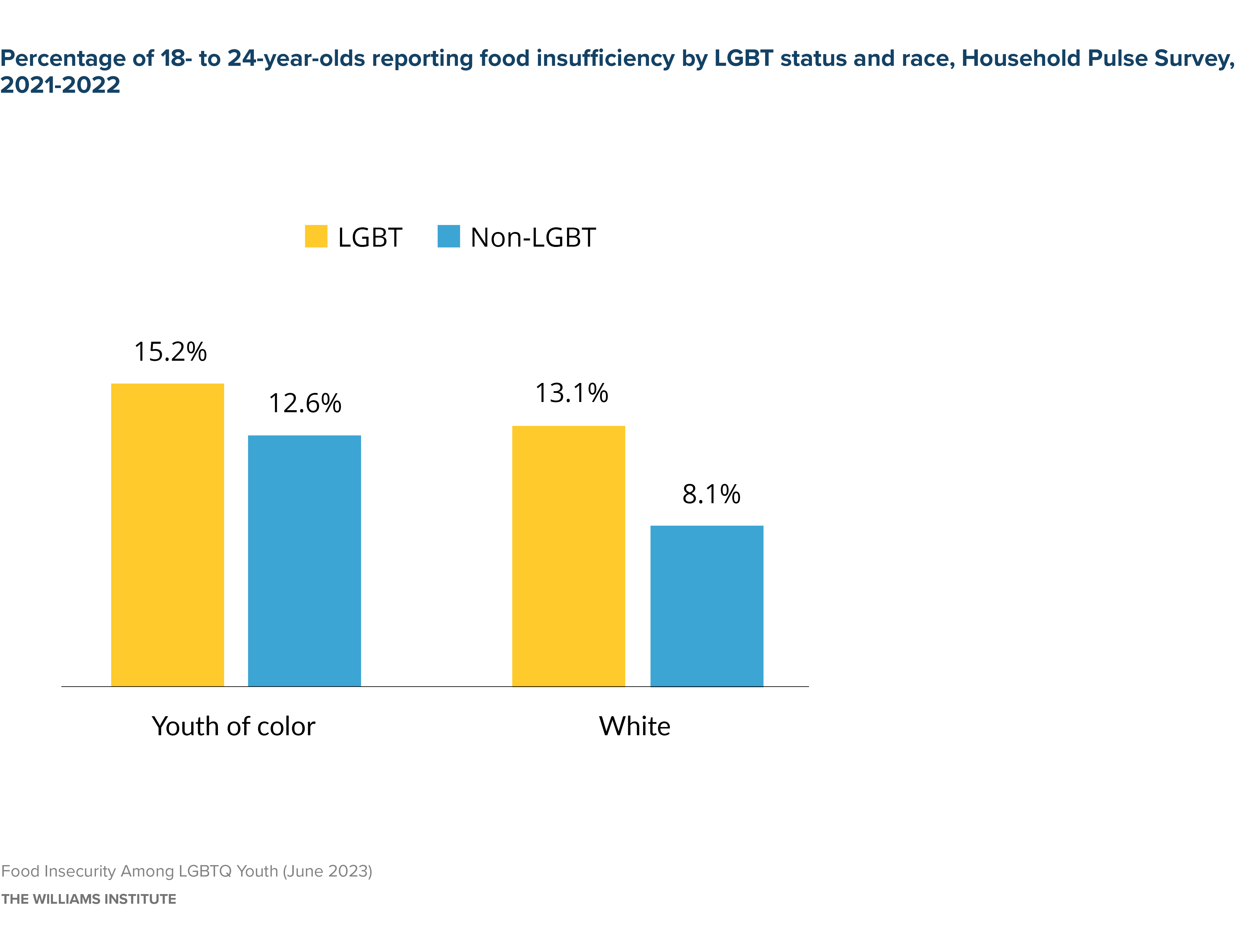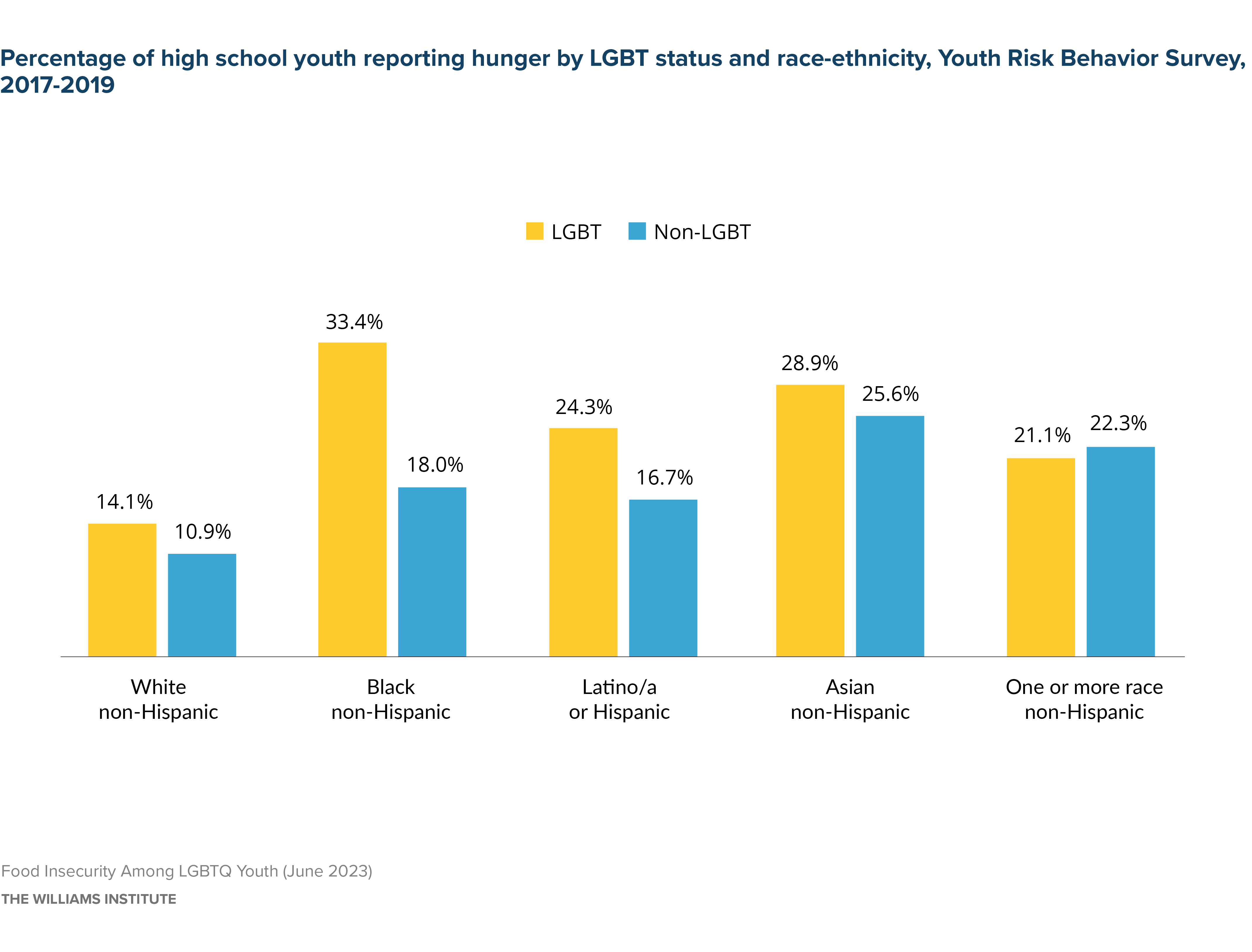This brief provides new information about food insecurity among LGBTQ youth. Inadequate access to food has been observed more often among LGBT than non-LGBT adults; however, less is known about access to food among youth.
Food insecurity, food insufficiency, and hunger are related experiences that are defined as follows:
Food insecurity indicates inadequate or uncertain access to food due to insufficient income or other resources. Prior research shows that food insecurity negatively impacts learning and health.
Food insufficiency refers to food inadequacies that lead to not having enough to eat. While food insecurity includes worrying about food running out (even if it has not yet run out) and having reduced quality or variety of foods (even if the amount of food is sufficient), food insufficiency is a very low level of food security, that is, when a person does not have enough to eat.
Hunger refers to a potential consequence of food insufficiency. Hunger is “discomfort, illness, weakness, or pain” caused by “prolonged, involuntary lack of food.” Food insufficiency does not necessarily cause hunger, but hunger is a possible outcome of food insufficiency.
This brief presents new analyses about the experience of self-reported hunger due to insufficient food at home among LGBT and non-LGBT high school youth using data collected on state Youth Risk Behavior Surveys. For LGBT and non-LGBT 18- to 24-year-olds, we use data from the U.S. Census Bureau’s Household Pulse Survey about food insufficiency experienced within the past seven days.
Hunger Among High School Youth
- One in five (20.1%) LGBT high schoolers in a three-state sample experienced hunger in the last 30 days because there was not enough food at home. In comparison, 15.7% of their non-LGBT peers experienced hunger because there was not enough food at home.
- Nationally, an estimated 371,000 LGBT high school students experience hunger due to food insecurity.
- Racial inequities in hunger due to food insecurity exist for LGBT and non-LGBT youth alike.
-
- More Black LGBT high school students report hunger than their non-LGBT Black peers (33.4% vs. 18.0%).
- School-based meals served through the National School Lunch Program and the School Breakfast Program are a reliable food source for millions of U.S. students; however, accessing school-based meals is more difficult for LGBTQ youth.
- About one in three LGBT high school youth has been bullied at school in the past year—about twice as many as their non-LGBT peers—which increases the likelihood of skipping school, avoiding the cafeteria, and missing meals to be safe.
- Nearly a third of LGBTQ+ youth (32.2%) who completed GLSEN’s 2021 National School Climate Survey missed a day of school in the past month because they felt unsafe or uncomfortable. More than one in ten (11.3%) missed four or more days of school.
- More than one in five (22.2%) LGBTQ+ youth avoided lunchrooms and cafeterias because they felt unsafe or uncomfortable.
- Strategies to improve access to food for high school LGBTQ youth include, at minimum, preventing school-based bullying and ensuring that LGBTQ youth can access food through the National School Lunch Program.
- National surveillance of hunger among high school students by sexual orientation and gender identity is essential. Information about the experiences of intersex youth is also needed.
Food Insufficiency Among Youth Ages 18-24
- More 18- to 24-year-old LGBT youth experienced food insufficiency, sometimes or often not having enough to eat, in the past week compared to their non-LGBT peers (13.9% vs. 10.1%).
- An estimated 703,000 LGBT 18- to 24-year-olds do not have enough to eat.
- Among food insufficient LGBT and non-LGBT older youth, more than half report that they could not afford to buy more food.
- About one-third of older LGBT and non-LGBT youth who were in the workforce between mid-July 2021 and the end of 2022 were not working in the past week.
- A larger proportion of older LGBT than non-LGBT youth reported difficulty paying for household expenses (16.6% vs. 12.0%) in the last week—including, but not limited to food, rent or mortgage, car payments, medical expenses, and student loans.
- Racial inequities in food insufficiency exist among LGBT and non-LGBT 18- to 24-year-olds. Among LGBT and non-LGBT older youth, more youth of color experience food insufficiency than their White, non-Hispanic peers.

Note: Differences between White, non-Hispanic youth and youth of color were statistically significant at p<0.05 among both LGBT and non-LGBT groups.

